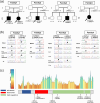Charcot-Marie-Tooth-like presentation in giant axonal neuropathy: clinical variability and prevalence in a large Japanese case series
- PMID: 40668264
- PMCID: PMC12267338
- DOI: 10.1007/s00415-025-13243-5
Charcot-Marie-Tooth-like presentation in giant axonal neuropathy: clinical variability and prevalence in a large Japanese case series
Abstract
Background: Giant axonal neuropathy 1 (GAN) is a rare neurodegenerative disorder with autosomal recessive inheritance and significant phenotypic heterogeneity, ranging from milder presentations resembling Charcot-Marie-Tooth disease (CMT) to classical presentations involving central and peripheral nervous systems. We investigated the genetic and clinical spectrum of GAN in Japanese patients with inherited peripheral neuropathies (IPNs).
Methods: We conducted genetic screening of 3315 Japanese patients diagnosed with IPNs between 2007 and 2023 using targeted next-generation or whole-exome sequencing. Variant pathogenicity, clinical features, and neurophysiological and neuroimaging findings were reviewed.
Results: We identified seven biallelic GAN variants in five patients from four unrelated families, including one homozygous and three compound heterozygous genotypes. Two novel pathogenic variants were identified: c.922G > T (p.Glu308*) and c.456dup (p.Ala153Cysfs*27). Two families exhibited the classical phenotype, whereas the other two exhibited a CMT-like phenotype. Mean onset age was 4.4 years (range 1.5-8), and gait disturbance was the initial symptom. The most common findings included distal weakness (n = 5), sensory impairment (n = 4), scoliosis (n = 3), autonomic dysfunction (n = 2). Neurophysiologically, all patients had sensorimotor axonal polyneuropathy. One patient with mild phenotype maintained a CMT-like state without systemic involvement until the age of 43 years and was still alive at 72, representing the longest documented survival in GAN.
Conclusion: This study expands the genetic and phenotypic spectrum of GAN by identifying novel variants and a long-term survivor. These findings underscore the importance of systematic genetic screening for GAN in pediatric-onset CMT, even in the absence of classical features.
Keywords: Charcot–Marie–Tooth disease; Giant axonal neuropathy; Gigaxonin; Inherited peripheral neuropathy; Next-generation sequencing; Phenotypic heterogeneity.
© 2025. The Author(s).
Conflict of interest statement
Declarations. Competing interests: The authors declare that they have no conflict of interest. Ethics approval and consent to participate: This study received approval from the institutional review board of Kagoshima University (Application ID: 490). All participants provided their informed consent for their involvement in this study. This study was conducted in accordance with the Declaration of Helsinki.
Figures


References
-
- Asbury AK, Gale MK, Cox SC, Baringer JR, Berg BO (1972) Giant axonal neuropathy-a unique case with segmental neurofilamentous masses. Acta Neuropathol 20(20):237–247. 10.1007/BF00686905 - PubMed
-
- Pascale B, Laurent C, François B et al (2000) The gene encoding gigaxonin, a new member of the cytoskeletal BTB/kelch repeat family, is mutated in giant axonal neuropathy. Nat Genet 26:370–374. 10.1038/81701 - PubMed
-
- Guo Y, Su Q, Zhu X et al (2022) Giant axonal neuropathy (GAN) in an 8-year-old girl caused by a homozygous pathogenic splicing variant in GAN gene. Am J Med Genet A 188(3):836–846. 10.1002/ajmg.a.62592 - PubMed
MeSH terms
Supplementary concepts
Grants and funding
LinkOut - more resources
Full Text Sources
Medical

